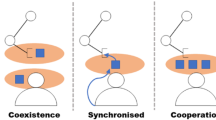Abstract
This article presents a method for tele-operated mobile robots to rapidly adapt to behavior policies. Since real-time adaptation requires frequent observations of sensors and the behavior of users, rapid policy adaptation cannot be achieved when significant data are not differentiated from insignificant data in every process cycle. Our method solves this problem by evaluating the significance of data for learning based on changes in the degree of confidence. A small change in the degree of confidence can be regarded as reflecting insignificant data for learning (that data can be discarded). Accordingly, the system can avoid having to store experience data too frequently, and the robot can adapt more rapidly to changes in the user’s policy. In this article, we confirm that by taking advantage of a significance evaluation not only of proposition of behavior, but also of each proposition of each piece of sensor-level data, a robot can rapidly adapt to a user’s policy. We discuss the results of two experiments in static and dynamic environments, in both of which the user switched policies between “avoid” and “approach.”
Similar content being viewed by others
References
Datar M, Gionis A, Indyk P, et al (2002) Maintaining stream statistics over sliding windows. Siam J Comput 31(6):1794–1813
Kifer D, Ben-David S, Gehrke J (2004) Detecting change in data streams. Proceedings of the 30th VLDB Conference, Toronto
Widmer G, Kubat M (1996) Learning in the presence of concept drift and hidden contexts. Mach Learn 23:69–101
Klinkenberg R (2004) Learning drifting concepts: example selection vs. example weighting. Intel Data Anal, Special Issue on Incremental Learning Systems Capable of Dealing with Concept Drift 8(3):281–300
Billsus D, Pazzani MJ (2000) User modeling for adaptive news access. User Modeling and User-Adapted Interaction 10:147–180
Chiu P, Webb G (1998) Using decision tree for agent modeling: improving prediction performance. User Modeling and User-Adapted Interaction 8:131–152
Jordan MI, Jacobs RA (1993) Hierarchical mixture of experts and the EM algorithm. Proceedings of the International Joint Conference on Neural Networks, pp 1339–1344
Haruno M, Wolpert DM, Kawata M (2001) MOSAIC model for sensorimotor learning and control. Neural Comput 13:2201–2220
Kaelbling LP, Littman ML, Moore AW (1996) Reinforcement learning:a survey. J Artif Intel Res 4:237–285
Inamura T, Inaba M, Inoue H (2004) PEXIS: probabilistic experience representation based adaptive interaction system for personal robots. Syst Comput Jpn 35(6):98–109
Inamura T, Inaba M, Inoue H (2000) User adaptation of human-robot interaction model based on Bayesian network and introspection of interaction experience. Proceedings of the International Conference on Intelligent Robots and Systems (IROS 2000), pp 2139–2144
Inamura T, Inaba M, Inoue H (1999) Acquisition of probabilistic decision model based on interactive teaching method. Proceedings of the 9th International Conference on Advanced Robotics, ICAR, pp 523–528
Nicolescu M, Mataric M (2001) Learning and interacting in human-robot domains. IEEE Trans Syst Man Cybern Part A: Syst Hum 31(5):419–430
Tareeq SM, Inamura T (2008) A sample discarding strategy for rapid adaptation to new situation for Bayesian behavior learning. Proceedings of the IEEE International Conference on Robotics and Biomimetics pp 1950–1955
Pearl J (1988) Probabilistic reasoning in intelligent system; network of plausible inference. 2nd edn. Morgan Kaufman, Los Altos
Michel O (2004) Webots: professional mobile robot simulation. J Adv Robotics Syst 1(1):39–42
Author information
Authors and Affiliations
Corresponding author
Additional information
This work was presented in part at the 15th International Symposium on Artificial Life and Robotics, Oita, Japan, February 4–6, 2010
About this article
Cite this article
Tareeq, S.M., Inamura, T. Rapid behavior adaptation for human-centered robots in a dynamic environment based on the integration of primitive confidences on multi-sensor elements. Artif Life Robotics 15, 515–521 (2010). https://doi.org/10.1007/s10015-010-0856-x
Received:
Accepted:
Published:
Issue Date:
DOI: https://doi.org/10.1007/s10015-010-0856-x




